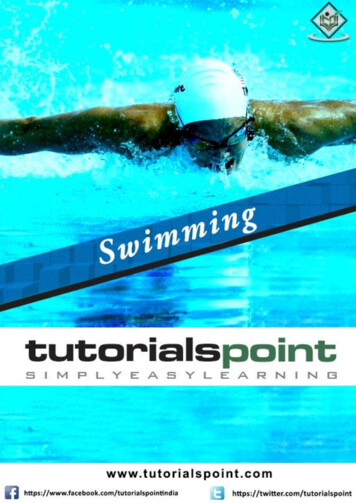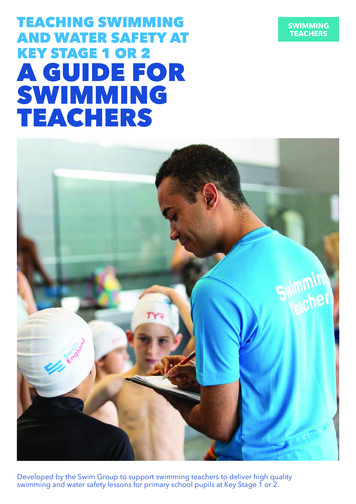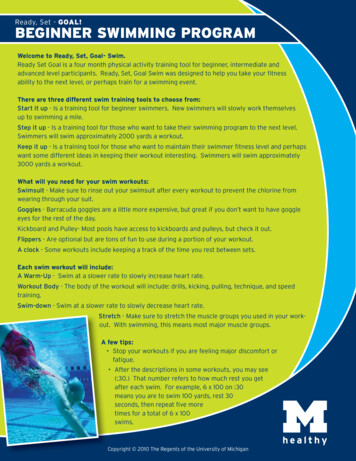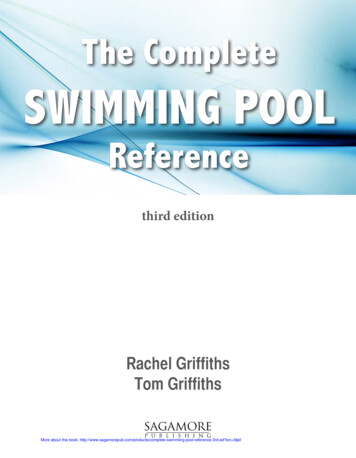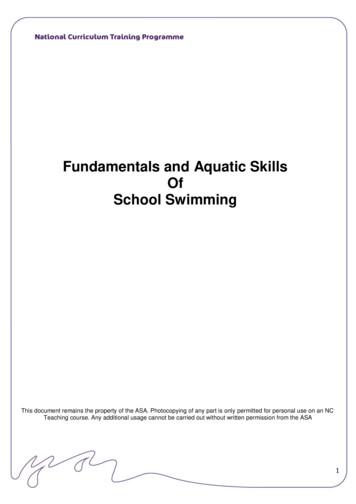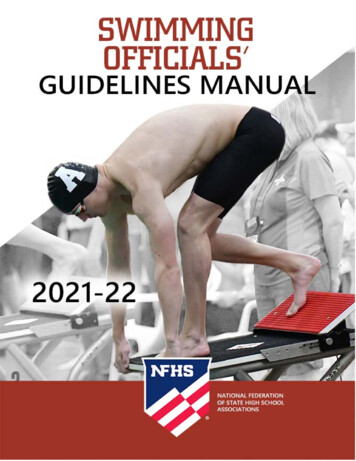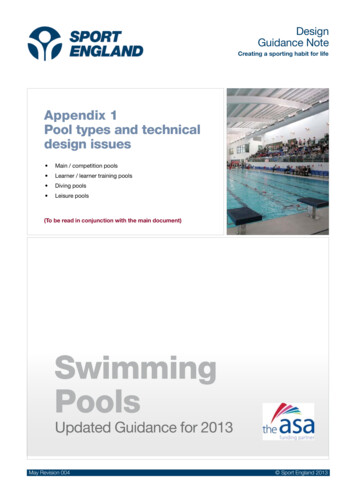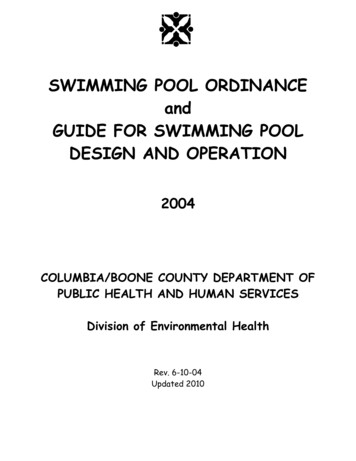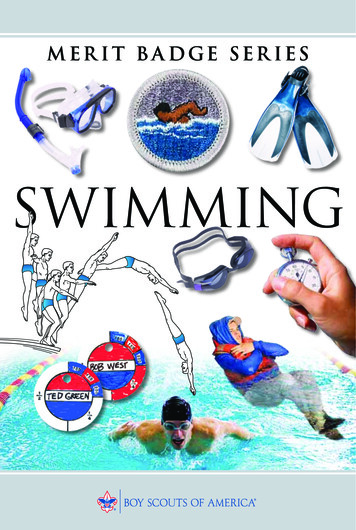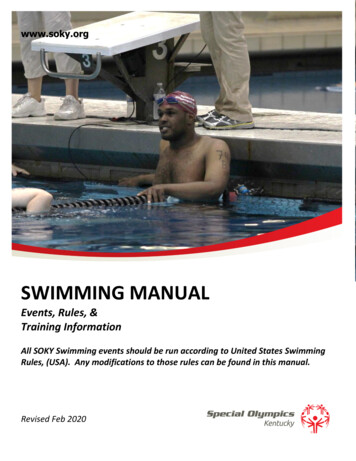
Transcription
www.soky.orgSWIMMING MANUALEvents, Rules, &Training InformationAll SOKY Swimming events should be run according to United States SwimmingRules, (USA). Any modifications to those rules can be found in this manual.Revised Feb 2020
Swimming ManualTABLE OF CONTENTSSwimming SeasonThe Benefits of SwimmingSport Development TeamEvents OfferedGeneral RulesHosting a MeetMeet InformationWhistle StartsFalse StartsSafety ConsiderationsPreparing for CompetitionAttire & EquipmentSC Stroke/Relay Information**25 Freestyle & 25 Backstroke LimitationDevelopmental EventsSC Strokes (diagrams)Teaching TipsSample WorkoutsTraining DrillsYour Role as a 3-4546-47INDEXMeet LogSwimming ResourcesDQ Cards495051-52** Effective September 21, 2017: USA Swimming Rule 101.6-101.7- Medley Swimming Modifications to Medley Swimming can be found on pages 17 & 18 in this manual.Modifications are in bold and underlined.2
Swimming SeasonJanuary – FebruaryTeams form and begin training for the seasonMarch – April – MaySwim Meets – Season consists of 4 - 6 meetsJuneState Swim Meet at Summer Games (Eastern Kentucky University)Meet dates and locations vary. Past locations include:University of Kentucky, University of Louisville, Northern Kentucky University, TransylvaniaUniversity, Lakeside (Louisville), Scott High School (NKY), Transylvania University, Mary T.Meager Center (Louisville), Asbury University, Silverlake Recreation Center (NKY), The Centerfor Courageous Kids (Scottsville).During the season, athletes must attend and compete in at least two (2)meets to qualify for the State Meet.To obtain a copy of theUSA Swimming Rulesplease visit:https://usaswimming.orgUSA Swimming1 Olympic PlazaColorado Springs, CO 80909(719) 866-45783
The Benefits of SwimmingPhysical Benefits Improves posture, flexibility, muscular endurance, strength and balance Stimulates circulation Promotes proper breathing Rehabilitates under-used or healing muscles Improves one’s ability to control and maintain a healthy weight Provides a great cardiovascular workout (potential of burning 350 – 420 calories perhour)Social Benefits A sport that is safe for all ages, at all fitness levels Lots of laughs and fun while getting a great workout Enjoyable even when working hard Provides social interaction opportunities at practices and meetsPsychological Benefits Encourages a positive attitude, through physical and skill progression Heightened sense of well-being Increased energy level Participation in competitive swimming helps set high expectations for achievementSwimming – A Skill for Life!4
SPECIAL OLYMPICS KENTUCKYSWIMMING SPORT DEVELOPMENT TEAMSOKY Sport Development TeamsEach SOKY Sport Development Team (SDT) is made up of 4-8 volunteers who come from awide range of backgrounds including, but not limited to, high school/college coaches andofficials, professionals in the field, instructors, and representatives from sport governingbodies and organizations, local program coaches and Special Olympics athletes. Using theguidelines set by Special Olympics International and under the guidance of the state ProgramDirector, the group will design policies, restructure rules, and help grow and strengthen ourstate’s program. The goal of this collaborative effort is to make sure our sports programscontinue to be the best for our athletes. The primary goals of each SDT are:1. Improve the quality of training and competition for SOKY athletes.2. Assess the needs of the respective sport and help develop and implement strategies tomeet those needs.3. Identify and recruit sport-specific resources.The SDT values the input from each athlete, coach, volunteer and parent. These individualsare invited to share their thoughts at SDT meetings.Swimming Sport Development Team MembersNick McKenzie- SOKY Program Manager, Individual SportsJan Krekel- Area 4Developmental Official/AwardsBrandi Wathen- Area 4Athlete StagingHead Coach: Pitt Polar BearsBill Krekel- Area 4Head of AwardsPhilip Norris- Area 8Head Coach: PiranhasDebbie Ogden- Area 7Head Coach: NKY Dolphins5
The Official Special Olympics Summer Sports Rules shall govern all Special Olympics Swimming Competitions. Special Olympics hascreated these rules based upon International Governing Body Rules, (FINA) and National Governing Body Rules, United StatesSwimming, (USA). USA Rules shall be employed except when they conflict with the Special Olympics Sports Rules. In such cases,official Special Olympics Rules shall apply. Athletes can register for up to two (2) individual events and one (1) relay event at eachcompetition.SHORT COURSE EVENTS OFFERED - All distances measured in yards.25 Freestyle*25 Breaststroke50 Freestyle50 Breaststroke100 Freestyle100 Breaststroke200 Breaststroke200 Backstroke4 x 25 Individual Medley4 x 25 Freestyle Relay4 x 50 Freestyle Relay4 x 25 Medley Relay4 x 50 Medley Relay25 Backstroke*25 Butterfly50 Backstroke50 Butterfly100 Backstroke100 Butterfly200 Freestyle200 Butterfly4 x 50 Individual Medley4 x 25 Unified Freestyle Relay4 x 50 Unified Freestyle Relay4 x 25 Unified Medley Relay4 x 50 Unified Medley Relay*During competition, any male who swims the 25 freestyle or 25 backstroke in 25.00 seconds and under will bedisqualified and receive a participation ribbon. Any female who swim the 25 freestyle or 25 backstroke in 30.00 secondsand under will be disqualified and receive a participation ribbon.DEVELOPMENTAL EVENTSCOACHES WHO HAVE ATHLETES IN DEVELOPMENTAL EVENTS NEED TO BE FAMILIAR WITH ENTRY RULES CONCERNINGLEAD-UP EVENTS.These events are intended for athletes of lower skill levels.15 Walk15 Flotation15 Flotation Kickboard15 Kickboard15 Assisted Freestyle15 Assisted Backstroke15 Unassisted Freestyle15 Unassisted Backstroke25 Transitional Freestyle25 Transitional Backstroke25 Assisted Swim25 Flotation2 x 25 Flotation Relay2 x 25 Kickboard Relay2 x 25 Relay*2 x 25 Unified Relay** Any combination of developmental events6
GENERAL RULESThe technical rules of competition are noted in the USA Rule Book. The USA Rule Book will be used for allevents. Some exceptions to these rules are listed below.1. ALL EVENTSa. The Meet Referee shall have the authority to adjust these rules on a case by case basis for thesafety and well being of an athlete. The referee may intervene in the competition at any stage toensure that the appropriate regulations are observed.b. The Meet Referee shall have the discretion to allow for certain modifications/interpretations of thecurrent technical rules based upon a physical disability characteristic. Such interpretation shall notgive advantage over another swimmer. Stroke interpretations will be concerned with the action alimb is performing. The stroke judge shall be concerned with what action the arm or leg actionconstitutes.c. The Referee shall have full control and authority over all officials, approve their assignments andinstruct them regarding all Special Olympics regulations related to competition. He/she shallenforce all rules and decisions of the Official Special Olympics Rules book and USA rules and shalldecide all questions to the actual conduct of the meet.d. During freestyle events, athletes may use any stroke and may change that stroke during the courseof the race should they choose to do so. The only exception is during the individual medley ormedley relay. In those events, athletes may use any stroke EXCEPT backstroke, breaststroke andbutterfly during the freestyle portion.e. Standing on the bottom during freestyle events or during the freestyle portion of the medleyevents shall not disqualify a competitor BUT the swimmer shall not be allowed to walk makingforward progress. Standing on the bottom is allowed only for the purpose of resting. Walking onor jumping from the bottom is cause for disqualification.f. A coach may guide the swimmer by voice only. A coach is not allowed to touch the swimmer fromthe time of the starting signal until all swimmers have completed the race.g. Assistant starters may be used to assist athletes in maintaining their positions at the starting line.h. No competitor shall be permitted to use or wear any device that may aid his speed, buoyancy orendurance during a competition such as; webbed gloves, flippers, etc. Goggles may be worn.i. Swimmers may be assisted from the water if needed. Athletes are not to be pulled out of the waterby their arms.j. During competition, athletes who finish their race should remain in their lane until everyonefinishes except during relay races.k. If your athlete has a physical restraint/disability that affects their stroke technique, you shouldsubmit a Stroke Difficulty Form to the state office before the first meet.l. An athlete is NOT allowed to grasp lane dividers to assist in forward motion.m. Breaststroke and butterfly turns are initiated by touching the wall with both hands.2. EQUIPMENTa. Starting device, (whistle, horn, gun). A visual start may be used for the hearing impaired. A strobelight in accordance with USA rules is recommended.b. Lanes Lines.c. Electronic Timing System and/or Stopwatches – at least one per laned. Backstroke Flags.7
3. RELAY EVENTSa. There shall be four (4) swimmers on each relay team.b. Individual stroke relay teams (4x25 Free and 4x50 Free) are allowed to have one (1) alternate. Thisalternate must be listed on the registration form, cannot be registered for any other relays (as amember or as an alternate), and must be the slowest leg of the relay team.c. Each swimmer shall swim ¼ the distance of the total relay. No swimmer shall swim more than oneleg of any relay.d. A relay team that combines genders to include both male and female athletes shall compete as amale relay.e. Relay swimmers should exit the pool as soon as possible following the completion of their relay leg.f. Unified Relays – teams shall consist of two (2) athletes and two (2) partners and the swimmersmay be assigned in any order.g. Unified Partners are allowed to enter one (1) short course relay event and one (1) developmentalrelay event per meet.4. DEVELOPMENTAL EVENTSa. Athletes participating in developmental events cannot enter short course events at the same meet.b. All athletes entering the 15 unassisted swim, the 25 transitional freestyle or the 25 transitionalbackstroke must possess recovery skills. A recovery skill is the method of recovering from a prone(horizontal) position to a standing (vertical position) without assistance or difficulty. Every attemptshould be made to train the athlete to complete the distance with assistance only at the start. Theathlete needs to possess the endurance to move 15-25 yards.c. FLOTATION DEVICES are those that encircle the body. Water wings are not acceptable. Flotationsthat may be used are: 1) Head floats 2) Inner tubes 3) Life Jackets/belts. Flotations must fit theathlete securely. KICKBOARDS CANNOT BE USED AS FLOTATIONS. Coaches are to provide allflotation devices and kickboards. Floatation does not have to be a Coast Guard approval device.d. Coaches are responsible for obtaining assistants for lifting athletes in and out of the pool. Pleasefollow good lifting techniques, ensure all safety and make sure all wheelchair brakes are in the lockposition. (i.e. feet planted, weight evenly distributed, bend knees, lift with legs and not back, etc.)With the exception of the unassisted swim and the transitional swim, it is required that an assistantaccompany the athlete into the water.e. Assistants’ hands must be visible at all times (out of the water is preferred). Any sculling or underwater hand movements may move the athlete forward, causing disqualification. Persons assistingathletes in an event are to guide or direct the athlete without assisting in forward movement.f. A touch cue may be necessary to communicate with the athlete. This can be done with a tap to theback, shoulder, arm, leg, etc. Immediately following the cue, the hands MUST be visible.g. Standing on the bottom in the racing course is allowed in flotation events, assisted events and the15 M unassisted event for the purpose of resting. Walking on or jumping from the bottom mustdisqualify the competitor. This rule will not apply for the 15 M walk.8
GUIDELINES FOR HOSTING A SWIM MEETMeet Officials – The following should be USA Certified:A. Referee - assign jobs - runs the deckB. Starter - starts raceC. Stroke and Turn JudgesAdditional Personnel needed:1. Head Timer - responsible for organizing timers2. Timers - two per lane3. Clerk of Course - staging person, swimmers check, scratches, etc.4. Awards – person to organize the awards process5. First AidFacilities Six to eight lane poolStarting blocksLane linesDepth of 4 ft. minimumBackstroke flagsFalse start rope1 Lifeguard for every 25 swimmersEntries Ensure all entries have valid SOKY medical Pre-meet packet – must include schedule, directions, specifics for meetKeys Keep staging away from pool deck Flow - Two Escorts/Heat9
SWIM MEET INFORMATION(Times are estimations and are subject to change from meet to meet) Meet requirements – All athletes must swim in 2 swim meets during the regularaquatics season to qualify for the state meet. If an athlete receives a participationribbon at a meet, that meet will count as one of the two required. Delegation check-in will begin 1 ½ hours before the scheduled start time of the meetand conclude 30 minutes prior to the start of the meet. Scratches must be turned in at least 30 minutes prior to the start of the meet. Warm-ups – Athletes will have a 15 to 30-minute period in the water to warm-up. Thewarm-up will conclude 15 minutes prior to the start of the meet. Coaches Meeting – 15-30 minutes prior to the start of the event there will be a briefcoaches meeting conducted by SOKY staff and meet directors. All head coaches arerequired to attend the coaches meeting. Adequate # of coaches / chaperones – Teams need to have enough personnel availableat meets to supervise team members who are awaiting or finished competition Staging – Coaches and chaperones will listen for the clerk of course to call for events.The staging of athletes will stay 3 to 4 events ahead of the current event. When anathlete’s event is called, a coach / chaperone will bring him or her to the staging area.The athlete should be checked in using their wristband and seated. Athletes will beseated in lane order. They will also receive a sponge that has their lane assignment on it.Escorts will lead the athletes to the starting blocks in a single file line, wait for thecompletion of the event and then lead the athletes back to their designated team area.Getting athletes to staging is the coach’s responsibility. Announcements will not bemade for individual swimmers. It is imperative that coaches and chaperones activelylisten for events to be called. They must look ahead in the event program to ensurethat each athlete is ready to go to staging. Athletes must bring everything they needfor the event to staging: goggles, swim cap, water, and towel.10
USA RULE CONCERNING WHISTLE STARTSAll Special Olympics Kentucky sanctioned swim meets will use this rule.Coaches, please train your athletes using the whistle start!THE RULE STATES:“At the commencement of each heat, the Referee shall signal to the swimmers by a shortseries of whistles, to remove all clothing except for swim wear and to stand ready at least onefoot distance from the block area. Next, swimmers will hear a long whistle indicating that theyshould take one of the following positions and remain there: On the platform (if diving from the block) pool edge (if diving from the side of the pool) or in the water (if performing an in-water start)When the swimmers and officials are ready, the Referee shall signal with an outstretched armto the Starter that the swimmers are under the Starter’s control.On the Starter’s command “take you mark”, the swimmers shall immediately assume theirstarting position with at least one foot at the front of the block, on the side or holding the wallwith an outstretched arm in the water. When all swimmers are stationary, the Starter shallgive the starting signal.”IMPORTANT CLAIFICATION ON FALSE STARTSUnder USA Swimming, there is No “Recall” for false starts.Under the no recall starting procedure, the penalty for a false start is imposed on the offenderafter the completion of the swim. Races will not be called back, even if the entire division falsestarts. The first start generally is the swimmer’s best effort. Therefore, swimmers should notbe penalized for a good start by having a race recalled due to someone false starting. Thestarter may recall a heat for usual circumstances, such as a lane line break, sudden noiseinterfering with the start signal, or anything that may affect fair conduct of the race.11
SAFETY CONSIDERATIONSBASIC RULESa. There shall be at least one certified lifeguard on duty for every 25 swimmers in thewater. (includes everyone in the pool)b. The sole function of the lifeguard shall be to guard. If no relief lifeguard is available, thepool must be emptied even for short durations when a lifeguard must leave the poolside.c. The head coach and assistants will review the emergency action plan.d. Athlete medical forms shall be on site for all practice sessions and meets.e. Pool depth must be marked and visible.f. Water depth should be 6 feet deep before beginning to teach the dive start from thedeck. At competition or practice, the minimum depth of the pool shall be 1.52 meters (5ft) for racing starts from a starting block. A swimmer may dive from the side of the poolwithout a starting block if the depth is at least 1.22 meters (4 ft).g. Safety lines must be in place to divide shallow and deepwater areas during recreationalaquatic activities.h. A pool facility shall not be used unless a satisfactory inspection rating is received prior toany Special Olympics athlete entering the water.i. All rescue and first aid equipment should be inspected on a regular basis and should beeasily accessible.j. An athlete with Down Syndrome who has been diagnosed with Atlanto-axial instabilitymay not participate in the butterfly stroke and/or dive starts.k. Coaches need to keep important medical devices and medications with them duringpractices and meets (including nebulizers, inhalers, and vegal nerve stimulators.)12
PREPARING FOR COMPETITIONIt is imperative that athlete training is done in a way to prepare athletes for competition.Several suggestions to aid in preparedness are:a. Prepare athletes by conducting your own practice meet. Include all elements such asstaging to simulate a real meet as closely as possible.b. Make sure that you practice the Whistle Start and commands so your athletes willrecognize them at a meet.c. Include a competition style warm-up at your practices.d. Prior to a meet, advise each athlete on what events they are competing in.TIPS FOR CONDUCTING A SAFE TRAINING SESSIONa.b.c.d.Establish clear rules for behavior at your first practice and enforce them.Teach athletes that when you hear the whistle, "stop, look, and listen."Athletes should ask the coach before they leave the pool deck.Always rope off the swimming areas so that athletes do not obstruct otherswimmers.e. Make sure athletes bring water to every practice, especially in hotter climates.f. Check your first-aid kit. Restock supplies as necessary.g. Identify the nearest phone that is accessible during practice.h. Ensure that the locker rooms and/or rest rooms are available and clean duringpractice.i. Train all athletes and coaches on emergency procedures.j. Do not allow athletes to swim while wearing watches, bracelets or jewelry, includingearrings.k. Provide proper stretching exercises after warming up at the beginning of eachpractice.l. Swimming aids and all other pool equipment should be in a designated place.m. Coaches should check the chemical levels before athletes enter the pool.n. Check for slippery deck conditions and remove standing water.o. Ensure that the correct number of certified lifeguards are present.13
SWIMMING ATTIRE & EQUIPMENTAppropriate swimming attire is required for all competitors. Clothing must be suited to the activities involved.Few sports require less equipment than swimming. Although equipment such as goggles and caps arerecommended, a Special Olympics athlete only needs a swimsuit to participate.Athletes and Unified Partners will not be allowed to compete wearing ANY jewelry. This includes necklaces,bracelets, rings, earrings, watches, etc.Swimsuits:The swimsuit can be anything that closely resembles skin in fit and feel. For males, any brief swim suit made ofsmooth, quick-drying fabric, such as nylon or Lycra, is fine. A one-piece suit is required for females. The suitneeds to be close-fitting, and cut so as not to hinder movements. The swimsuit needs to be substantial enoughto stay on the athlete's body while they train. Also be sure that the suit does not become transparent whenwet. Racing suits, whether for men or women, will provide less drag and provide more efficiency in the water.Suits with flotation devices built in are only allowed in flotation events.Cap:A tight-fitting, stretch swimmer's cap is recommended. Swim caps will prevent the hair from falling in theswimmer's face and thus provide less of a distraction. Besides keeping the swimmer's hair dry, the cap alsoreduces water drag and resistance.Goggles:Swim goggles are encouraged. Goggles allow the swimmers to comfortably put their faces in the water, thusallowing for better body position and more efficiency. There must be careful adherence safety with the use ofthis equipment. There are several varieties of goggles that allow for differences in each swimmer's facialstructure.Nose Clips:Nose clips are helpful for athletes who have difficulty controlling their breathing or who have sinus problems.Such clips should be used only when necessary.Water Bottle:Proper hydration is directly linked with an athlete’s health and performance. Water bottles are allowed onthe deck.Other attire/equipment that might be needed includes towels, flip-flops/water shoes, and event equipment(including flotation devices, kickboards, etc)Coaches Apparel:Coaches should be presentably dressed and preferably wearing a shirt with a collar. Coaches should also beprepared to get into the water if necessary. This sometimes means wearing a swimsuit under clothing14
SHORT COURSE STROKE/RELAY INFORMATIONAll stroke information can be found in the USA Swimming rulebook. However, it has beenadded to this manual for convenience.FREESTYLEa. START - The forward start shall be used.b. STROKE – In an event designated freestyle, the swimmer may swim any style, exceptthat in a medley relay or an individual medley event, freestyle means any style otherthan butterfly, breaststroke or backstroke. Some part of the swimmer must break thesurface of the water throughout the race, except it shall be permissible for the swimmerto be completely submerged during the turn and for a distance of not more than 15 m(16.4 y) after the start and at each turn. By this point the head must have broken thesurface. The swimmer may stop and stand during this event as long as they do not walk,push themselves off the bottom or propel themselves along the lane line.c. TURNS – Upon completion of each length, the swimmer must touch the wall. If theswimmer misses a touch, he/she may return to that end to touch anytime prior totouching at the end of the next length.d. FINISH – The swimmer shall have finished the race when any part of his person touchesthe wall after completing the prescribed distance.BACKSTROKEa. START – The swimmer shall line up in the water facing the starting end with both handsplaced on the gutter or starting grips. Standing in or on the gutter, placing the toesabove the lip of the gutter or bending the toes over the lip of the gutter, before or afterthe start, is prohibited. When using a backstroke ledge at the start, the toes of both feetmust be in contact with the end wall or face of the touchpad. Bending the toes over thetop of the touchpad is prohibited.b. STROKE – The swimmer shall push off on his back and continue swimming on the backthroughout the race. Some part of the swimmer must break the surface of the waterthroughout the race, except it is permissible for the swimmer to be completelysubmerged during the turn and for a distance of not more than 15 meters (16.4 y) afterthe start and after each turn. By that point, the head must have broken the surface ofthe water.c. TURNS – Upon completion of each length, some part of the swimmer must touch thewall. During the turn, the shoulders may be turned past the vertical toward the breast15
after which an immediate continuous single arm pull or immediate continuoussimultaneous double arm pull may be used to initiate the turn. The swimmer must havereturned to a position on the back upon leaving the wall.d. FINISH – Upon the finish of the race, the swimmer must touch the wall while on theback.BREASTROKEa. START – A forward start shall be used.b. STROKE – After the start and after each turn when the swimmer leaves the wall, thebody shall be kept on the breast. It is not permitted to roll onto the back at any timeexcept at the turn after the touch of the wall where it is permissible to turn in anymanner as long as the body is on the breast when leaving the wall. Throughout the race,the stroke cycle must be one arm stroke and one leg kick in that order. All movementsof the arms shall be simultaneous and in the same horizontal plane without alternationmovement. The hands shall be pushed forward together from the breast on, under, orover the water. The elbows shall be under water except for the final stroke before theturn, during the turn and for the final stroke at the finish. The hands shall not bebrought back beyond the hip line, except during the first stroke after the start and eachturn. During each complete cycle, some part of the swimmer’s head shall break thesurface of the water. After the start and after each turn, the swimmer may take one armstroke completely back to the legs. The head must break the surface of the water beforethe hands turn inward at the widest part of the second stroke.c. KICK – After the start and each turn, at any time prior to the first breaststroke kick asingle butterfly kick is permitted. Following which all movements of the legs shall besimultaneous and in the same horizontal plane without alternating movement. The feetmust be turned outwards during the propulsive part of the kick. Scissor, alternatingmovements or downwards butterfly kicks are not permitted except as provided herein.Breaking the surface of the water with the feet is allowed unless followed by adownward butterfly kick.d. TURN & FINISH – At each turn and at the finish of the race, the touch shall be made withboth hands separated and simultaneously at, above or below the water level. At the laststroke before the turn and at the finish an arm stroke not followed by a leg kick ispermitted. The head may be submerged after the last arm pull prior to the touch,provided it breaks the surface of the water at some point during the last complete orincomplete cycle preceding the touch.16
BUTTERFLYa. START – The forward start shall be used.b. STROKE – After the start and after each turn, the swimmer’s shoulders must be at orpast the vertical toward the breast. The swimmer is permitted one or more leg kicks, butonly one arm pull under water, which must bring the swimmer to the surface. It shall bepermissible for a swimmer to be completely submerged for a distance of not more than15 m (16.4 y) after the start and after each turn. By this point the head must havebroken the surface. The swimmer must remain on the surface until the next turn orfinish. From the beginning of the first arm pull, the body shall be kept on the breastexcept at the turn after the touch of the wall where it is permissible to turn in anymanner as long as the body is on the breast when leaving the wall. Both arms must bebrought forward simultaneously over the water and pulled back simultaneously underthe water throughout the race.c. KICK – All up and down movements of the legs and feet must be simultaneous. Theposition of the legs or feet need not be on the same level but they shall not alternate inrelation to each other. A scissors or breaststroke kicking movement is not permitted.d. TURNS – At each turn the body shall be on the breast. The touch shall be made withboth hands separated and simultaneously at, above or below the water surface. Once atouch has been made, the swimmer may turn in any manner desired. The shouldersmust be at or past the vertical toward the breast when the swimmer leaves the wall.e. FINISH – At the finish, the body shall be on the breast and the touch shall be made withboth hands separated and simultaneously at, above or below the water surface.INDIVIDUAL MEDLEYa. The swimmer shall swim the prescribed distance in the following order: the first ¼ –butterfly; the second ¼ - backstroke; the third ¼ - breaststroke; and the last ¼ freestyle.b. START – A forward start shall be used.c. STROKE – The stroke for each ¼ of the designated distance shall use the prescribed rulesfor that stroke, except in the freestyle, the swimmer must be on the breast exceptwhen executing a turn.d. TURNS – Intermediate turns within each stroke shall conform to the turn rules for thatstroke, except that in the freestyle turn, the swimmer must return to the breast beforeany kick or stroke. The turns when changing from one stroke to another shall conformto the finish rules for the stroke just completed, and shall be as follows:i. Butterfly to backstroke – The swimmer must touch as described in finish forbutterfly. Once a legal touch has been made, the swimmer may turn in any17
manner, but the shoulders must be at or past the vertical toward the back w
Swimming Resources 49 DQ Cards 50 ** Effective September 21, 2017: USA Swimming Rule 101.6-101.7- Medley Swimming Modifications to Medley Swimming can be found on pages 17 & 18

